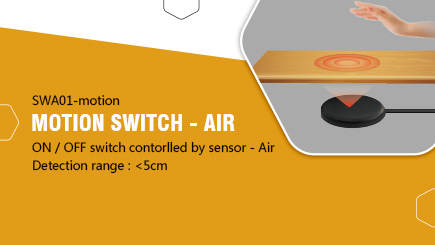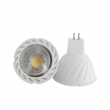LED package to take light efficiency
2017-05-25 14:48:37
Conventional LED lights there is a lack of brightness and other shortcomings, which led to the penetration rate is not enough. Low-power LED lights have a long life advantage, but the power LED has a package and other technical difficulties, the following simple analysis of the power LED package to take light efficiency factors.
First, the impact of light extraction efficiency of the packaging elements
Cooling technology
For light-emitting diodes consisting of PN junctions, when the forward current flows from the PN junction, the PN junction has heat loss, which is radiated into the air via adhesive, potting material, heat sink, etc., during this process. Part of the material has a thermal resistance to prevent heat flow, that is, thermal resistance, thermal resistance by the device size, structure and material determined by the fixed value. The thermal resistance of the LED is Rth (℃ / W) and the heat dissipation power is PD (W). At this time, the temperature of the PN junction is increased due to the heat loss of the current:
T (° C) = Rth × PD
PN junction temperature is:
TJ = TA + Rth × PD
Where TA is the ambient temperature. Due to the rise in junction temperature will make the probability of PN junction recombination decreased, the brightness of the light-emitting diodes will decline. At the same time, due to heat loss caused by the increase in temperature, light-emitting diode brightness will no longer continue to increase with the proportion of the current, that shows the hot saturation phenomenon. In addition, as the junction temperature rises, the peak wavelength of the light emission will drift to the long wavelength, about 0.2-0.3 nm / ° C. For the white LED obtained by mixing the YAG phosphor coated with the blue chip, Drift, will cause a mismatch with the phosphor excitation wavelength, thereby reducing the overall luminous efficiency of the white LED, and lead to white color temperature changes.
For power light-emitting diodes, the drive current is generally more than a few hundred milliamperes, PN junction current density is very large, so PN junction temperature is very obvious. For the packaging and application, how to reduce the thermal resistance of the product, so that the heat generated by the PN junction can be released as soon as possible, not only can improve the product saturation current, improve product luminous efficiency, but also improve product reliability and life The In order to reduce the thermal resistance of the product, the first choice of packaging materials is particularly important, including heat sink, adhesive, etc., the thermal resistance of each material is low, that requires good thermal conductivity. Second, the structural design should be reasonable, the thermal conductivity of the material between the continuous match, the material between the thermal connection is good, to avoid the heat generated in the heat pipe bottleneck to ensure that heat from the inner to the outer layer of distribution. At the same time, from the process to ensure that the heat in accordance with the pre-designed cooling channel in a timely manner out.
2. Reflective treatment
Reflective processing mainly has two aspects, one is the reflection of LED chip internal processing, the second is the reflection of the material on the light, through the inside and outside the two aspects of reflection processing, to improve the proportion of light from the chip injection, reduce the chip internal absorption , To improve the luminous efficiency of power LED products. From the package, the power LED is usually the power chip assembled with a reflective cavity on the metal bracket or substrate, the bracket-type reflective cavity is generally taken to improve the reflective effect of plating, and the substrate-type reflective cavity is generally used to polish Way, the conditions will also be electroplating, but the above two kinds of processing methods by the mold accuracy and process effects, after treatment of the reflective cavity has a certain reflection effect, but not ideal. At present, the domestic production of substrate-based reflective cavity, due to lack of precision polishing or metal coating oxidation, reflection effect is poor, which led to a lot of light in the refraction area after being absorbed, can not reflect the desired target to the smooth surface, resulting in the final After the package to take light efficiency is low.

3. Phosphor selection and coating
For white power LED, the improvement of luminous efficiency is also related to the choice of phosphor and process. In order to improve the efficiency of the phosphor to stimulate the blue chip, the first choice of phosphor to be appropriate, including the excitation wavelength, particle size, excitation efficiency, etc., need a comprehensive assessment, taking into account the various performance. Secondly, the coating of the phosphor should be uniform, and it is preferable that the thickness of the adhesive layer of each light-emitting surface is uniform, so that the local light can not be emitted due to uneven thickness, and the quality of the spot can be improved.
4. The choice of filler
According to the law of refraction, when the light is incident from the optical density medium to the optical sparse medium, the total emission occurs when the incident angle reaches a certain value, that is, greater than or equal to the critical angle. The refractive index of the GaN material is 2.3, and the critical angle θ0 = sin-1 (n2 / n1) is given when the light is emitted from the inside of the crystal to the air.
Where n2 is equal to 1, i.e., the refractive index of air, and n1 is the refractive index of GaN, whereby the critical angle? 0 is calculated to be about 25.8 degrees. In this case, the light can be emitted only the incident angle ≤ 25.8 degrees in the space of the solid angle of light. It is reported that the external quantum efficiency of GaN chip is about 30% -40%, therefore, due to the internal absorption of the chip crystal, can be injected into the crystal outside the proportion of light is very small. It is reported that the current GaN chip external quantum efficiency of 30% -40%. Similarly, the light emitted by the chip through the packaging material, sent to the space, but also consider the impact of material on the efficiency of light extraction.
Therefore, in order to improve the efficiency of LED products to take light, you must improve the value of n2, that is, to improve the refractive index of the packaging material to improve the critical angle of the product, thereby enhancing the product packaging luminous efficiency. At the same time, the packaging material to light absorption is small. In order to increase the proportion of light emitted, the outline of the package is preferably arched or hemispherical, so that light from the package material to the air, almost perpendicular to the interface, and thus no longer produce total reflection.





